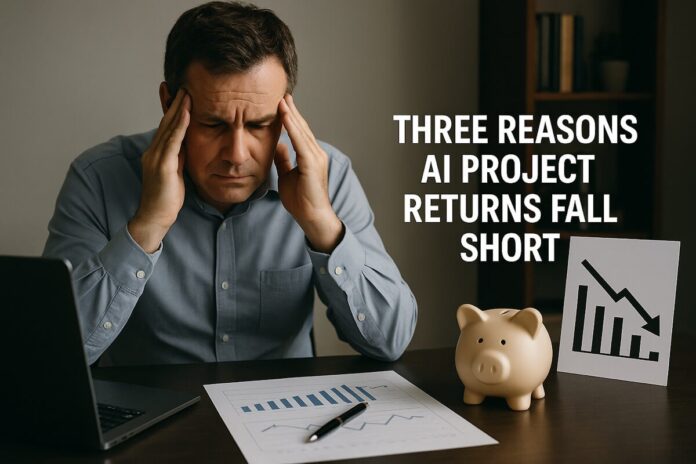AI was supposed to be the golden goose. You put in some data, get predictions, save time, reduce costs, and maybe even launch a new product line. But that’s not what most CTOs are seeing. Instead of a solid return, many are scratching their heads wondering where all that budget went — and why the payback is so underwhelming.
Let’s cut the fluff and get real. AI isn’t magic. It needs more than just hype and talent to pay off. So what’s going wrong?
Here are three hard-hitting reasons why AI’s financial returns are letting most CTOs down.
1. Too Much Focus on the Tech, Not Enough on the Problem
Let’s be honest — some teams get carried away chasing the newest algorithm or building the flashiest model. It’s easy to fall into that trap when everyone’s talking about AI models that can write, draw, speak, or do backflips (okay, not yet). But here’s the thing: no tech solves anything if it’s not tied to a real, clear business problem.
Many AI projects start without a well-defined use case. Or worse, they target problems that aren’t critical to the business. This leads to fancy demos and slick proof-of-concepts… that never actually get rolled out. And if they do, they don’t deliver measurable impact.
CTOs are now realizing that technical success doesn’t always mean business success. A model that predicts churn with 92% accuracy sounds great — until you realize the cost of acting on it outweighs the savings.
The right starting point isn’t the model. It’s the business pain. What’s the problem? Why does it matter? What’s the cost of not solving it?
Without that clarity, even a high-performing AI solution won’t move the needle.
2. Talent Shortages and Hiring the Wrong People
Finding the right AI talent is hard. Full stop.
There’s a big difference between someone who knows how to train a model and someone who knows how to make that model useful in a business setting. The market is flooded with resumes, but very few folks have the real-world experience that actually matters.
Some companies go the DIY route. They stack up a team of data scientists fresh out of bootcamps and let them loose on company data. Others try to poach experienced engineers and hope they can figure out the business side on the go. Neither works well.
That’s why a lot of CTOs now look to Hire AI Developers from trusted external teams who’ve done this before — not just built models, but delivered outcomes. External experts bring in something internal teams often lack: battle-tested experience across industries, clearer execution plans, and the discipline to say “no” to ideas that won’t pay off.
And let’s not forget hiring is just one side of it. Interviews are another bottleneck.
Sifting through resumes, setting up technical screens, and evaluating skills takes time — and it’s often hit-or-miss. This is where tools like an AI interview platform come into play. They speed things up, make evaluations more consistent, and help weed out unqualified candidates early. Less time wasted. Better hires made.
So if your AI project is stalling because of talent issues, maybe the hiring process needs a reset too.
3. Data Woes and Integration Headaches
Data is where most AI dreams go to die.
Everyone knows AI needs data. But not everyone has the data they think they do. And even when they do, it’s often messy, incomplete, locked in outdated systems, or scattered across departments that don’t talk to each other.
This isn’t just a technical issue. It’s organizational.
You’ve got data in spreadsheets, CRMs, ERPs, cloud buckets, and maybe even tucked away in PDFs. Stitching all that together into a usable format takes serious time and effort — and often reveals a bigger issue: the business wasn’t ready for AI in the first place.
Add to that privacy concerns, compliance hurdles, and security worries, and it’s no surprise that AI projects get stuck in the mud before they even start.
Some companies try to skip this step. They feed whatever data they can find into the model and hope for the best. That’s like trying to bake a cake with half the ingredients missing and still expecting it to rise.
Want results? Fix your data. Make sure it’s clean, accessible, and aligned with what you’re trying to achieve. If you can’t trust your data, you can’t trust your AI.
So, What’s the Fix?
Here’s a thought — instead of jumping headfirst into AI, maybe it’s time to pause and ask: why are we doing this?
Start with business impact. Not buzzwords. What will success look like? How will we measure it? Who will use this thing once it’s built?
Then, focus on hiring not just any developer, but ones who’ve delivered real outcomes. Whether you decide to Hire AI Developers from outside or build internally, make sure they’ve seen what works and what doesn’t.
Also, don’t skimp on your hiring tools. The right AI interview platform can make or break your team-building efforts. With the right folks in place, the chances of a project actually making money go way up.
And lastly, tackle your data issues head-on. It’s not glamorous, but it’s necessary. Good data is the foundation. Without it, everything else is just fluff.
Wrapping It Up: Hype vs Reality
AI can work. It really can. But only when it’s built with purpose, backed by clean data, and executed by the right people.
CTOs are realizing that flashy models and cool demos aren’t enough. You need clarity, discipline, and a bit of skepticism to make AI projects deliver results that actually show up on the balance sheet.
If you’re not seeing returns yet, maybe it’s time to stop chasing the hype — and start fixing what’s really broken.





















